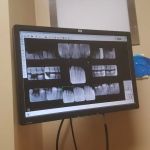Signs of a Cavity and How to Treat It: A Complete Guide to Protecting Your Teeth
- 1. Recognizing the Signs of a Cavity
- 2. Pain and Sensitivity: What Your Teeth Are Telling You
- 3. How Cavities Develop: Understanding the Process
- 4. Treatment Options: How to Fix a Cavity
- 5. Prevention Tips: How to Keep Cavities at Bay
- 6. Explore More Dental Care Products
1. Recognizing the Signs of a Cavity
Identifying the signs of a cavity early is key to preventing further damage to your teeth. Cavities, also known as dental caries, develop when harmful bacteria break down the enamel of your teeth. But how do you know when you might have a cavity? It's not always obvious, but there are common signs to look out for.
1.1 Visible Holes or Dark Spots on Teeth
One of the most noticeable signs of a cavity is the presence of visible holes or dark spots on your teeth. These areas may appear discolored, either dark brown or black, indicating that the enamel has worn away.
1.2 Persistent Toothache
If you experience a persistent, dull toothache or sharp pain when chewing, it could be a sign that decay has reached the inner layers of your tooth. This type of pain may worsen over time, especially when you consume hot, cold, or sweet foods.
2. Pain and Sensitivity: What Your Teeth Are Telling You
Another key indicator that you might have a cavity is heightened tooth sensitivity. This can occur when the protective enamel has been damaged, exposing the sensitive inner tissues of the tooth.
2.1 Sensitivity to Hot and Cold
If your teeth react painfully to hot or cold foods and drinks, this could be a sign of a cavity. Sensitivity occurs when the tooth’s inner layer, called the dentin, becomes exposed. A cavity may be causing this exposure.
2.2 Pain When Eating Sweet Foods
Cavities can also cause sharp pain when consuming sugary foods. This is because the bacteria in the cavity are feeding on sugar, creating acid that irritates the nerve inside the tooth. If you experience this pain, it’s important to seek dental treatment as soon as possible.
3. How Cavities Develop: Understanding the Process
Understanding how cavities form can help you prevent them in the future. Cavities start when bacteria in your mouth feed on sugars and starches from the food you eat, producing acids that erode tooth enamel. Here’s a look at the process:
3.1 Early Stage: Enamel Erosion
In the early stages, acid attacks weaken the enamel, creating small white spots. This is when the cavity is easiest to prevent. You may not feel any pain or notice any symptoms at this point, but the damage to the enamel has begun.
3.2 Progression to Dentin and Pulp
As the cavity progresses, the decay spreads beyond the enamel and into the dentin, which is the softer tissue beneath the enamel. This can cause pain and sensitivity. If left untreated, the decay may reach the pulp, the innermost part of the tooth, leading to infection and further complications.
4. Treatment Options: How to Fix a Cavity
Once a cavity has formed, it’s crucial to seek professional dental treatment to prevent further damage. Treatment options vary depending on the severity of the cavity.
4.1 Fillings
The most common treatment for a cavity is a filling. The decayed portion of the tooth is removed, and the cavity is filled with materials like composite resin, amalgam, or porcelain. Fillings restore the tooth’s function and prevent further decay.
4.2 Root Canal Treatment
If the cavity has reached the pulp and caused an infection, a root canal may be necessary. This involves removing the infected tissue and sealing the tooth to prevent future problems.
4.3 Crowns
For larger cavities, a crown may be recommended. A crown is a custom-made cap that covers the entire tooth, restoring its shape and function while protecting it from further damage.
5. Prevention Tips: How to Keep Cavities at Bay
Preventing cavities is all about maintaining good oral hygiene and making healthier food choices. Here are some tips to keep your teeth strong and cavity-free:
5.1 Brush and Floss Regularly
Brushing your teeth at least twice a day with fluoride toothpaste and flossing daily are the best ways to prevent plaque buildup and tooth decay. Make sure to clean all surfaces of your teeth and gums to remove food particles and bacteria.
5.2 Limit Sugary and Acidic Foods
Limit your intake of sugary and acidic foods that can erode tooth enamel. When you do consume them, try to brush your teeth afterward or rinse your mouth with water to neutralize the acids.
5.3 Regular Dental Check-ups
Visiting your dentist for regular check-ups is crucial. Dentists can detect early signs of cavities and provide treatment before the problem worsens.
6. Explore More Dental Care Products
If you’re looking to take better care of your teeth, explore products designed to fight cavities and promote oral health. At Dentistry Toothtruth, you can find a range of products to enhance your dental routine, from toothpaste to mouthwashes that help prevent cavities.
Learn more about our recommended dental care products and take the first step toward a healthier smile today!







 Armendariz Family Dentistry - Bethany Armendariz5.0 (310 review)
Armendariz Family Dentistry - Bethany Armendariz5.0 (310 review) West Coast Dental of South Gate3.0 (495 review)
West Coast Dental of South Gate3.0 (495 review) Bryn Mawr Periodontal Associates, Ltd.4.0 (277 review)
Bryn Mawr Periodontal Associates, Ltd.4.0 (277 review) Dental Solutions of Bala Cynwyd4.0 (448 review)
Dental Solutions of Bala Cynwyd4.0 (448 review) Little Smiles Dental - Pediatric Dentist Worcester4.0 (801 review)
Little Smiles Dental - Pediatric Dentist Worcester4.0 (801 review) SmileLine Dental: Dr. Geeta Choudhary, DDS4.0 (87 review)
SmileLine Dental: Dr. Geeta Choudhary, DDS4.0 (87 review) The Importance of Oral Health Education During Pregnancy for a Healthy Pregnancy
The Importance of Oral Health Education During Pregnancy for a Healthy Pregnancy Best Tips for Brushing Your Teeth Properly for Healthy Gums: Essential Techniques for Oral Health
Best Tips for Brushing Your Teeth Properly for Healthy Gums: Essential Techniques for Oral Health Why Skipping Dental Checkups Can Lead to Bigger Oral Health Problems
Why Skipping Dental Checkups Can Lead to Bigger Oral Health Problems Advantages of Porcelain Dental Restorations
Advantages of Porcelain Dental Restorations How Can Diabetes Cause Tooth and Gum Problems? Preventing and Managing Oral Health Issues
How Can Diabetes Cause Tooth and Gum Problems? Preventing and Managing Oral Health Issues Healthy Habits for Promoting Good Oral Health and Hygiene: Tips for a Healthy Smile
Healthy Habits for Promoting Good Oral Health and Hygiene: Tips for a Healthy Smile